VDNKh. The City of Soviet Antiquity
a neglected industrial display as a new acropolis
a neglected industrial display as a new acropolis
The USSR was a legendary country where everything was based upon mythology and the future was the only relevant time category. It was a country of dreamers. By the year so and so communism will be attained. And every Soviet family will flourish in prosperity, with free apartments and all sorts of commodities showering on them - in the future, by the year so and so. The present was smirky and unstable, and the past completely crossed out.
But it was necessary to incorporate that almost sacramental attitude towards the future into some sort of material basis that would have some sort of time reference. And then - of all epoques of human history - the Antiquity was ladled out. Good choice! This resulted in a curious configuration - both from the point of view of history as well as art history. The Soviet myth seemed to derive from things like ancient democracy of the Athens and the Roman republic. To derive immediately, skipping all the later chapters of human history as if it were some sort of irrelevant nonsense. And the All-Soviet agricultural exhibition (as it was originally called) that later evolved into the Exhibition of the Achievements of the Peoples' Industry became a model of that ideal state, a Soviet empire in miniature. But it's not safe to joke with History. By Jove, the History is sensitive to jokes of the kind. You wanted irony on the history level, didn't you? Well, here you are. The dignified pavilions resembling ancient temples that served to showcase industrial achievements eventually degraded into kiosks selling seeds and honey (for whatever reason). Just the way the neo-antique Soviet empire lost all its provinces, its miniature model, the Exhibition of achievements of the Peoples' Industry lost letters - the acronym changed from VDNKh into VVC (the All-Russian Exhibition Centre). But the most appropriate name for the place would be the Soviet history disneyland.
So here it is - the crumbling away stucco, the cracked columns and degraded sculptures, and now it seems that the Soviet antiquity resembles the Greek and Roman prototypes more than ever. It looks almost older...
Where are now the fattened pigs, cows, horses and sheep that several decades ago filled those pavilions symbolizing the achievements of Soviet industry and agriculture - from rabbit breeding to computer science? And where are the people, the legendary hard-working Soviet people, pioneers of industrialization and conquerors of the space? Where are they, the contemporaries of my parents and grand-parents, those who had the letters "USSR" once stamped into the passport and forever into the heart? They are long gone, vanished in time and sunken into dust. Like a lost civilization, like the people of the Atlantis. Only their shadows - one walking with a stick, one walking a grandson or a deaf dog, one wearing an old-fashioned straw hat - they shuffle around the half-antique half-ruins. Walking at a slow pace, they are taking their time to remember the glorious past that they have rushed past by because at that epoch people lived only for, and mostly in, the future.
But it was necessary to incorporate that almost sacramental attitude towards the future into some sort of material basis that would have some sort of time reference. And then - of all epoques of human history - the Antiquity was ladled out. Good choice! This resulted in a curious configuration - both from the point of view of history as well as art history. The Soviet myth seemed to derive from things like ancient democracy of the Athens and the Roman republic. To derive immediately, skipping all the later chapters of human history as if it were some sort of irrelevant nonsense. And the All-Soviet agricultural exhibition (as it was originally called) that later evolved into the Exhibition of the Achievements of the Peoples' Industry became a model of that ideal state, a Soviet empire in miniature. But it's not safe to joke with History. By Jove, the History is sensitive to jokes of the kind. You wanted irony on the history level, didn't you? Well, here you are. The dignified pavilions resembling ancient temples that served to showcase industrial achievements eventually degraded into kiosks selling seeds and honey (for whatever reason). Just the way the neo-antique Soviet empire lost all its provinces, its miniature model, the Exhibition of achievements of the Peoples' Industry lost letters - the acronym changed from VDNKh into VVC (the All-Russian Exhibition Centre). But the most appropriate name for the place would be the Soviet history disneyland.
So here it is - the crumbling away stucco, the cracked columns and degraded sculptures, and now it seems that the Soviet antiquity resembles the Greek and Roman prototypes more than ever. It looks almost older...
Where are now the fattened pigs, cows, horses and sheep that several decades ago filled those pavilions symbolizing the achievements of Soviet industry and agriculture - from rabbit breeding to computer science? And where are the people, the legendary hard-working Soviet people, pioneers of industrialization and conquerors of the space? Where are they, the contemporaries of my parents and grand-parents, those who had the letters "USSR" once stamped into the passport and forever into the heart? They are long gone, vanished in time and sunken into dust. Like a lost civilization, like the people of the Atlantis. Only their shadows - one walking with a stick, one walking a grandson or a deaf dog, one wearing an old-fashioned straw hat - they shuffle around the half-antique half-ruins. Walking at a slow pace, they are taking their time to remember the glorious past that they have rushed past by because at that epoch people lived only for, and mostly in, the future.
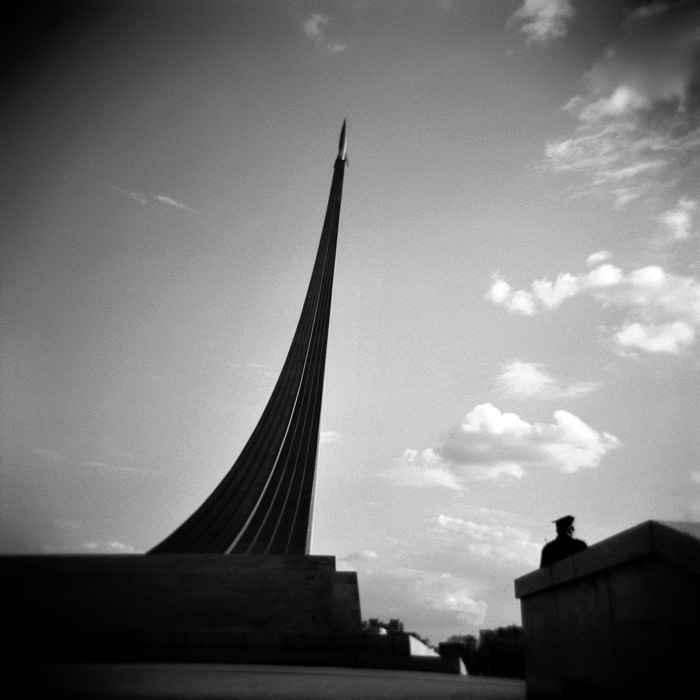
/ Monument to the Conquerors of the Space, next to the entrance to VDNKh metro station, by sculptor A. Fidysh-Krandievsky and architects A.Kolchin and M.Barsch, built in 1964 to commemorate the first Soviet satellite's 7th launch anniversary. /

/ A man selling horse rides to the visitors at the entrance to VDNKh. /
Until it became an industrial display, this place was called the All-Soviet Agricultural Exhibition, opened in 1939. Before the October Revolution, and even after it, Russia was mainly an agricultural country, its income mainly coming from grain export.
Until it became an industrial display, this place was called the All-Soviet Agricultural Exhibition, opened in 1939. Before the October Revolution, and even after it, Russia was mainly an agricultural country, its income mainly coming from grain export.
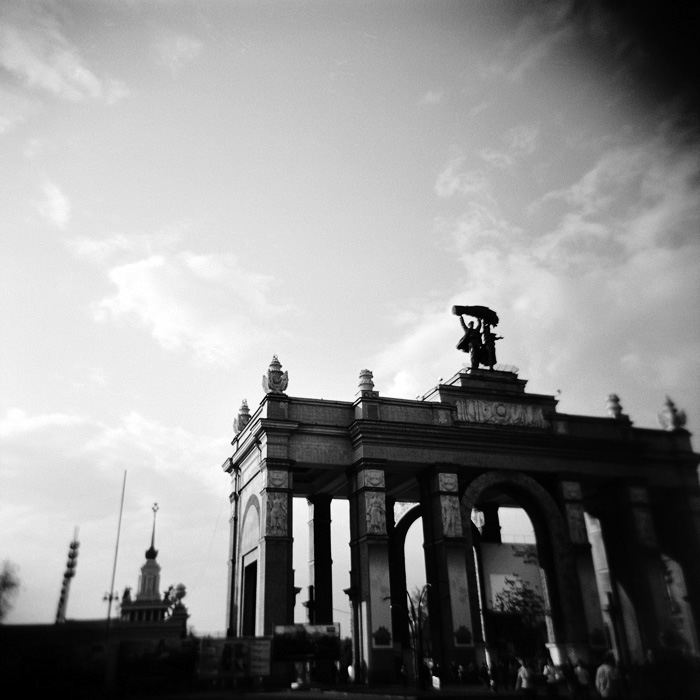
/ Main entrance to VDNKh portico, built in 1954 by architect I.Melchakov. /
Modeled from triumph arches of the antiquity, the entrance is in architectural proclamation in itself, an invitation to come and celebrate the victories of the Soviet industry, to reap the harvest of the command economy. Over 70 pavilions, each showcasing the produce of the empire, something to be proud of and compose hymns about, lay beyond these gates of the kingdom of the soviet Mercury.
Modeled from triumph arches of the antiquity, the entrance is in architectural proclamation in itself, an invitation to come and celebrate the victories of the Soviet industry, to reap the harvest of the command economy. Over 70 pavilions, each showcasing the produce of the empire, something to be proud of and compose hymns about, lay beyond these gates of the kingdom of the soviet Mercury.
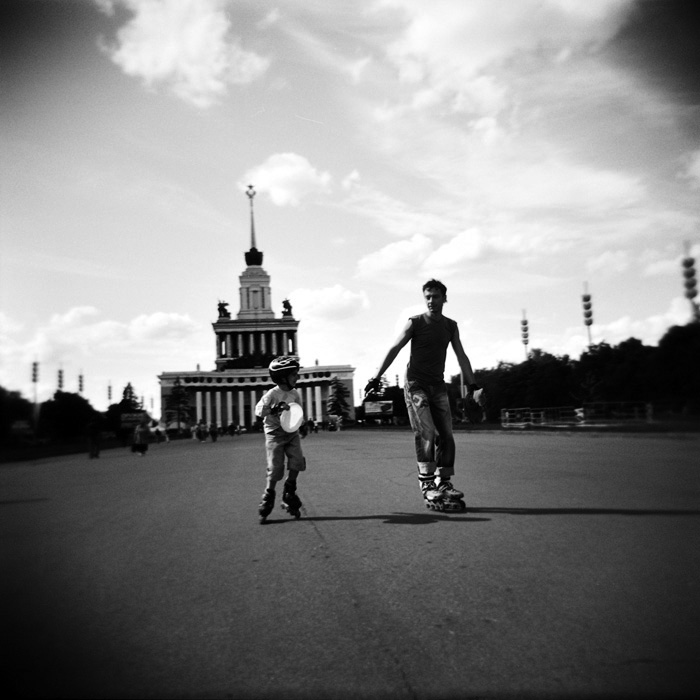
/ Father and son roller-skating in the central alley of VDNKh, with the Central (also known as the USSR) pavilion in the background. It was built in 1939 by architects Y.Schuko and E.Stolyarov. /
The so-called "Stalin architecture", that flourished in Moscow in the late 1940s through late 1950s was modeled from this tower-like building.
The so-called "Stalin architecture", that flourished in Moscow in the late 1940s through late 1950s was modeled from this tower-like building.
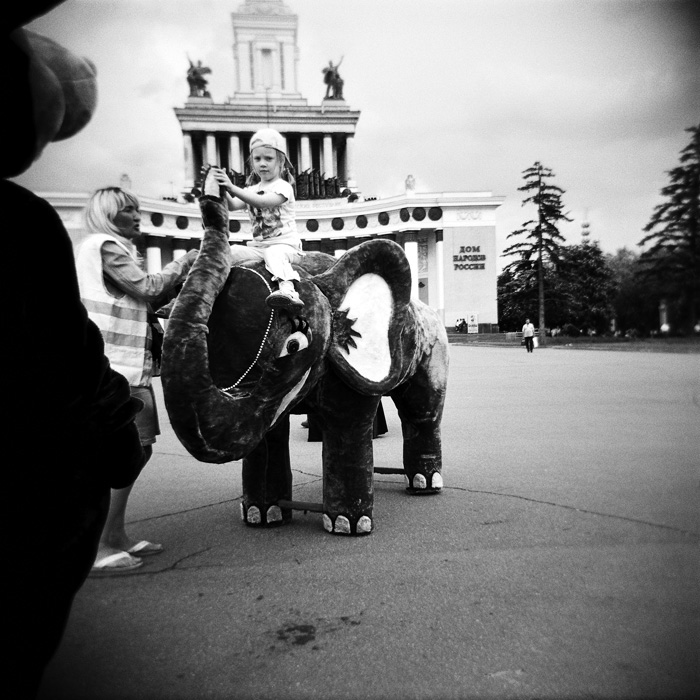
Soviet Union generated a lot of myths. It was a mother- and fatherland to all the most progressive, most revolutionary phenomena, to say nothing of people. One of such myths, or proverbs, was that the USSR was the fatherland of elephants...

Now the whole place resembles a huge filming set or an attractions park - at the very least... Industry display did not outlive the empire. On the contrary, economic ruin was the forerunner of the political collapse. Even perestroika, which literally means 'reconstruction', did not help to save the shaking Babel tower.
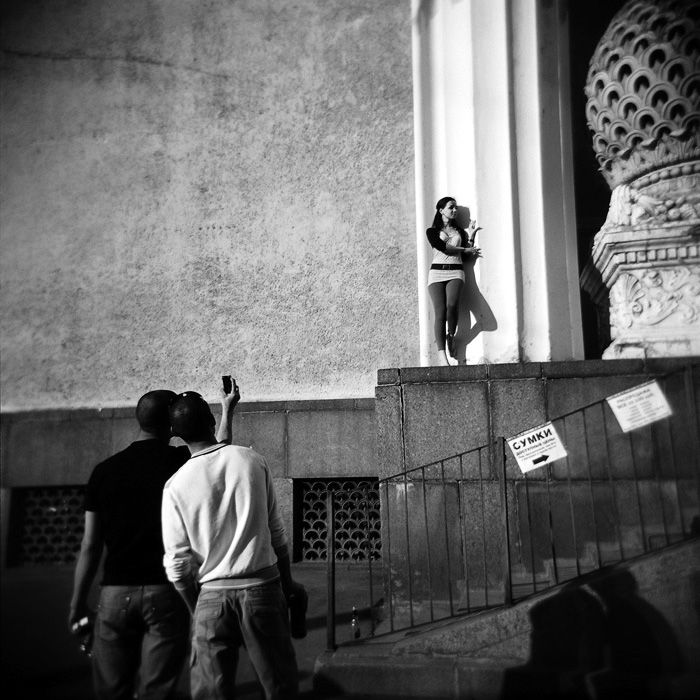
Architecture of the Central pavilion (former USSR pavilion) could serve as a decoration for a Roman empire epic.

/ Girls selling camel rides in the central alley of the VDNKh. /
Just like the empire of Alexander the Great, part of the Soviet Union lay in Central Asia.
Just like the empire of Alexander the Great, part of the Soviet Union lay in Central Asia.
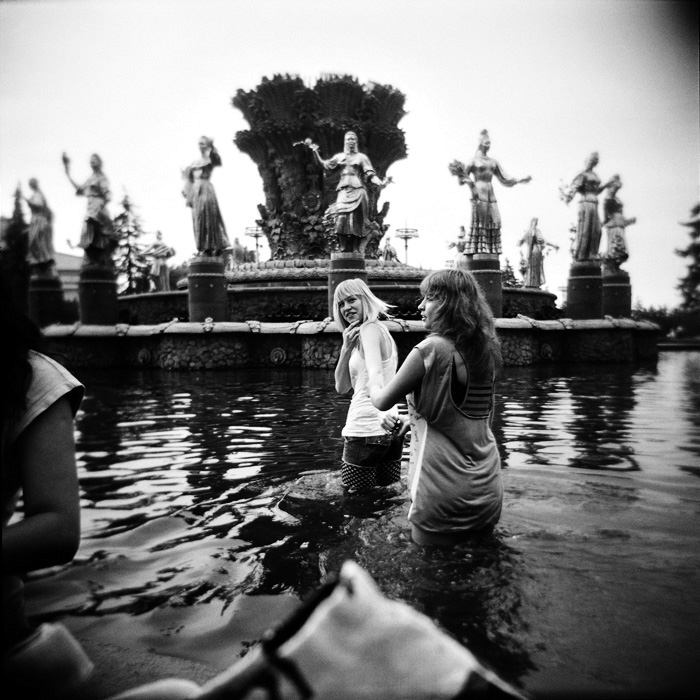
/ Girls wading through the water of the Peoples' Friendship fountain at VDNKh, on the final day of school in late May /
The key feature of the fountain are sixteen female statues symbolizing 16 republics of the Soviet Union, despite the fact that there were, in fact, 15 republics. How could have the system overlooked the error? The thing is, the number is correct, Soviet Union did initially number 16 republics, but the republic of Korelia was later abolished, the respective statue remaining to complete the ensemble.
The key feature of the fountain are sixteen female statues symbolizing 16 republics of the Soviet Union, despite the fact that there were, in fact, 15 republics. How could have the system overlooked the error? The thing is, the number is correct, Soviet Union did initially number 16 republics, but the republic of Korelia was later abolished, the respective statue remaining to complete the ensemble.
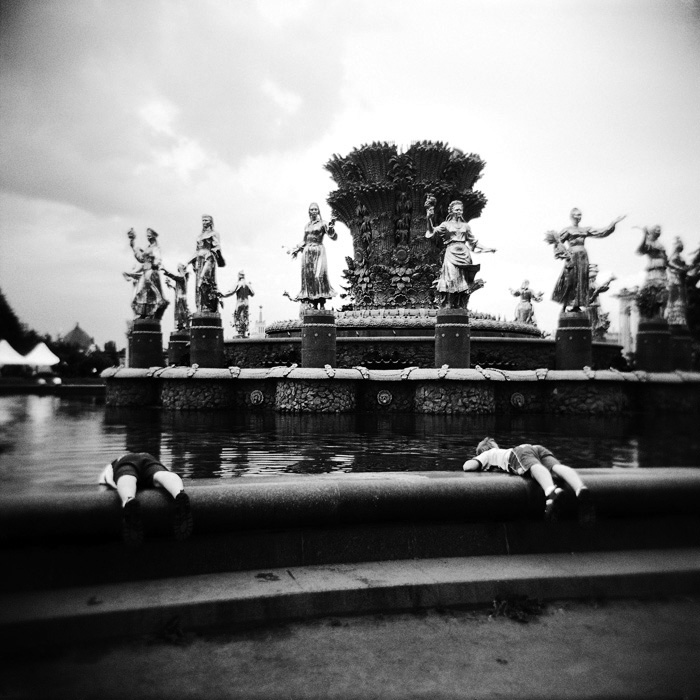
/ Two children are hovering over the Peoples' Friendship fountain at the VVC, former VDNHk. The fountain was built in 1954 by architects K.Topuridze and G.Konstantinovsky, sculptors Z.Bazhenova and L.Bazhanova. /
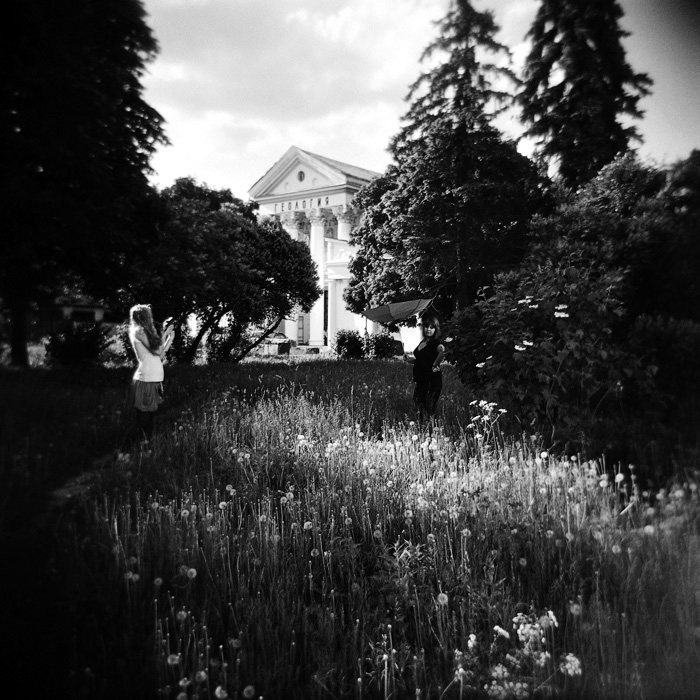
/ A girl taking a picture of her friend holding an umbrella, in the thereabouts of Geology pavilion at VDNKh. Geology pavilion, former Flax Industry pavilion, was built in 1939 by architects V.Andreev and I.Tarakanov. /
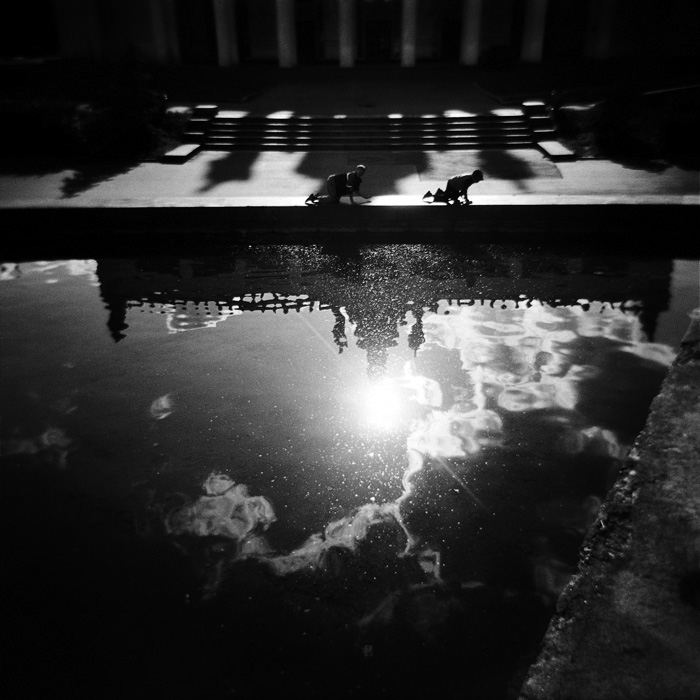
/ Two little boys crawling along the rim of a fountain in front of Transport (former Argiculture) pavilion. The outstanding pavilion portico was built in 1939-1954 by architects P.Revyakin and A.Gromov. /
Childhood was a beloved theme in Soviet art. Playing children, children doing gymnastics, children with aeroplane models, always happy looking, they served as a time reference, as an embodiment of 'the Bright Tomorrow'.
Childhood was a beloved theme in Soviet art. Playing children, children doing gymnastics, children with aeroplane models, always happy looking, they served as a time reference, as an embodiment of 'the Bright Tomorrow'.
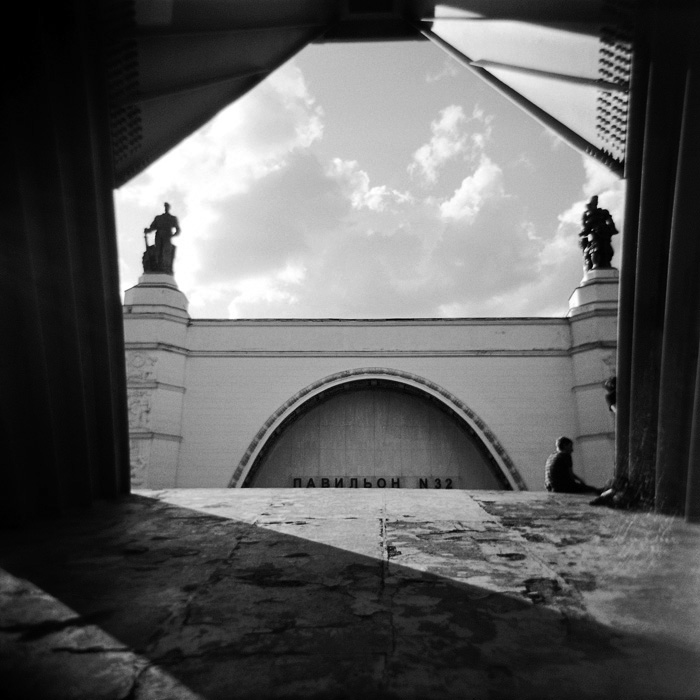
/ Space pavilion facade as seen through the launching block of Vostok spaceship. Space (former Mechanization) pavilion was built in 1939-1954 by architects V.Andreev and I.Tarakanov. /

/ Ornamental roof of the rotonda in front of Culture pavilion at VDNKh. The pavilion was built in 1939 by architect S.Polupanov and was originally the pavillion of the Uzbek Soviet republic. /
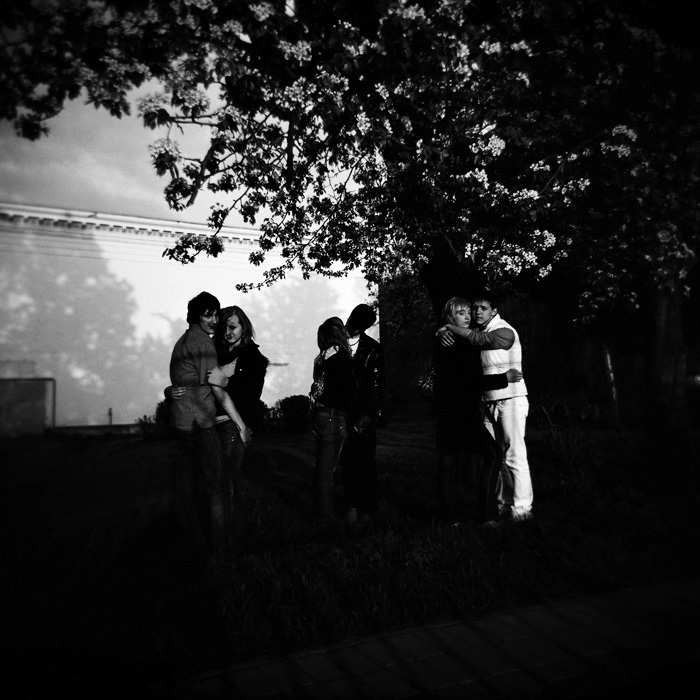
/ Three teenage couples hugging under a blooming apple tree at VDNKh. /
Soviet art was not interested in middle-aged or elderly people, it only depicted youth, in all kinds of media: paint, plaster, mosaics. Young workers, young teachers, young engineers, young athletes... It didn't need old people, because old means 'from the past', while the Soviet Union was something that had appeared from scratch, not even from today, it was from tomorrow.
Soviet art was not interested in middle-aged or elderly people, it only depicted youth, in all kinds of media: paint, plaster, mosaics. Young workers, young teachers, young engineers, young athletes... It didn't need old people, because old means 'from the past', while the Soviet Union was something that had appeared from scratch, not even from today, it was from tomorrow.
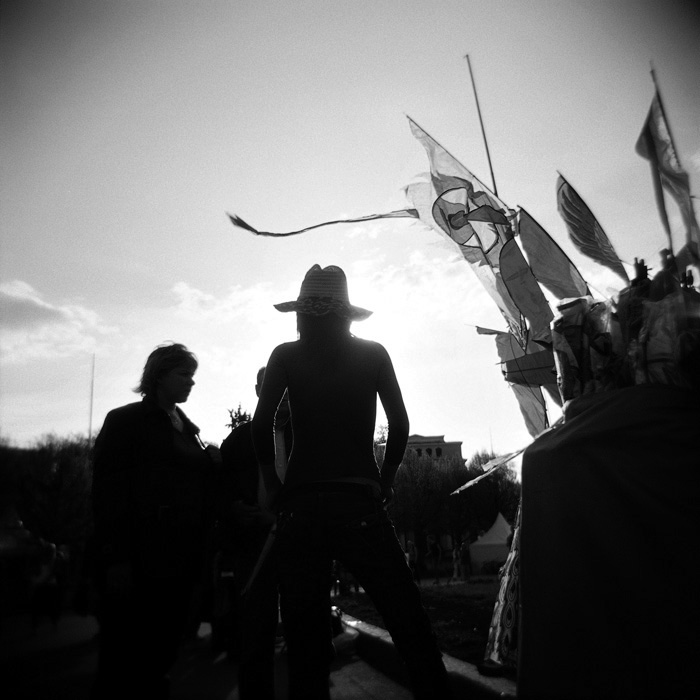
/ A kite vendor and her customers at VDNKh. /
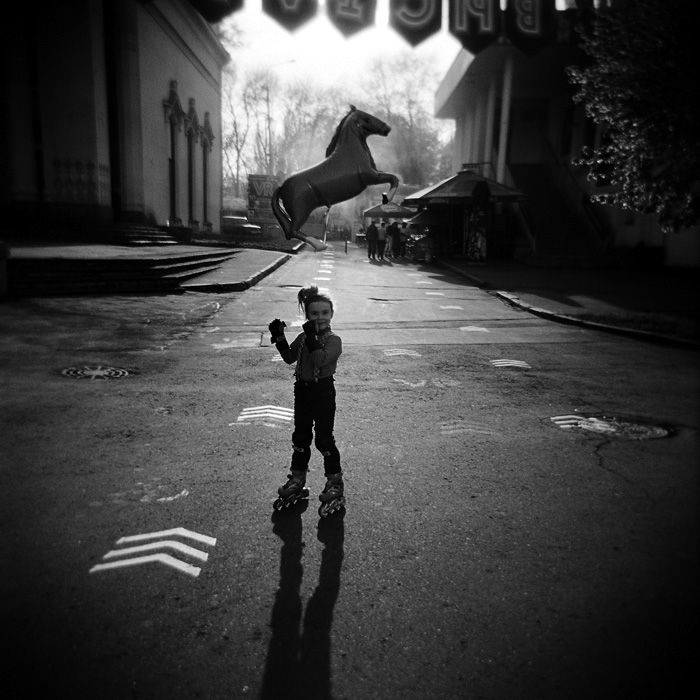
/ A girl with a horse-shaped balloon. /
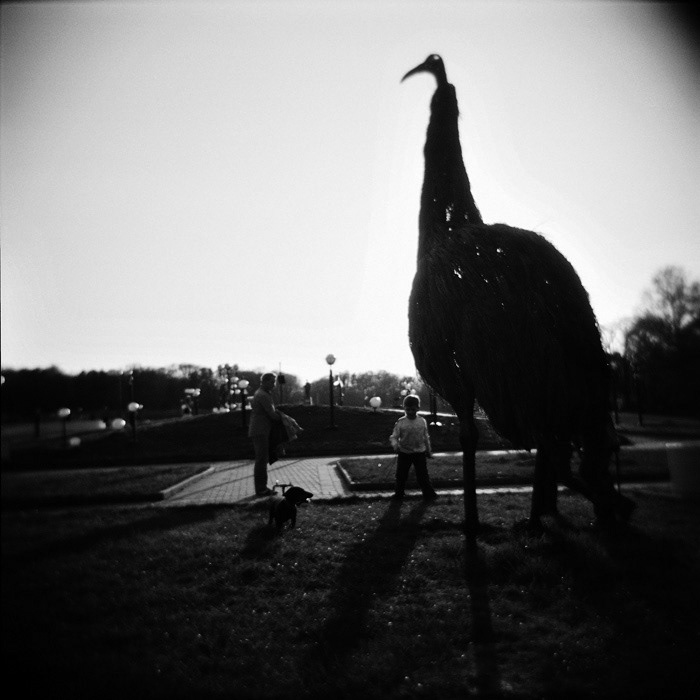
/ A huge bird made of branches in the apple garden named after I.Michurin at VDNKh. /
I.Michurin (1855-1935) was an outstanding Russian biologist, founder of plant breeding science and a repression victim.
I.Michurin (1855-1935) was an outstanding Russian biologist, founder of plant breeding science and a repression victim.
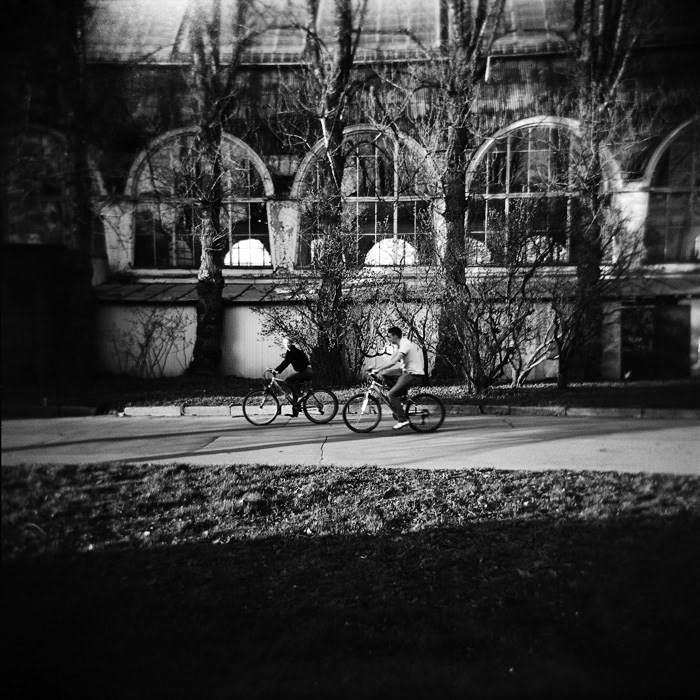
/ A young couple cycling along a side facade of Space pavilion at VDNKh. /
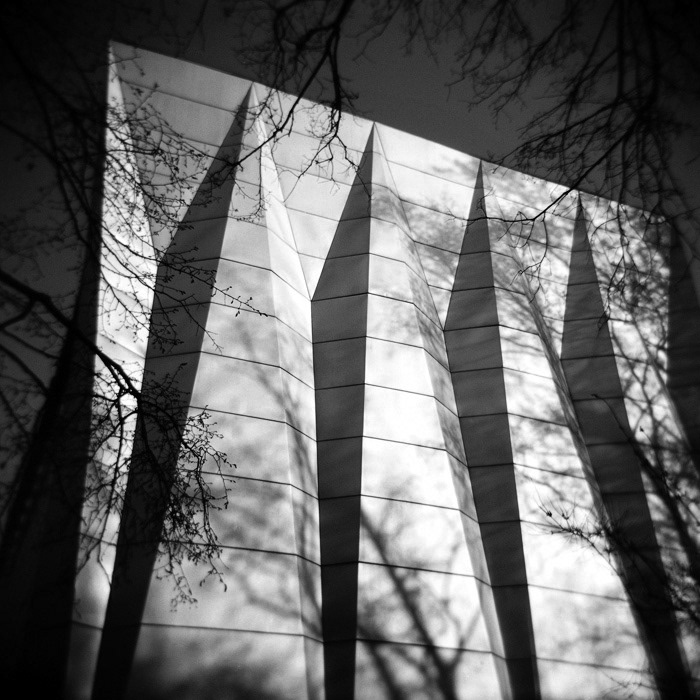
/ Radioelectronics pavilion at VDNKh. Originally it was built as the Volga region pavilion, and its side facade (in the pic) is an allusion to the steel structure of a bridge on the Larger Volga cascade. The building was completed in 1939 by architect S. Znamensky and converted into the Radioelectronics pavilion in 1954 by architects E. Yakovlev and I. Shoshensky. /
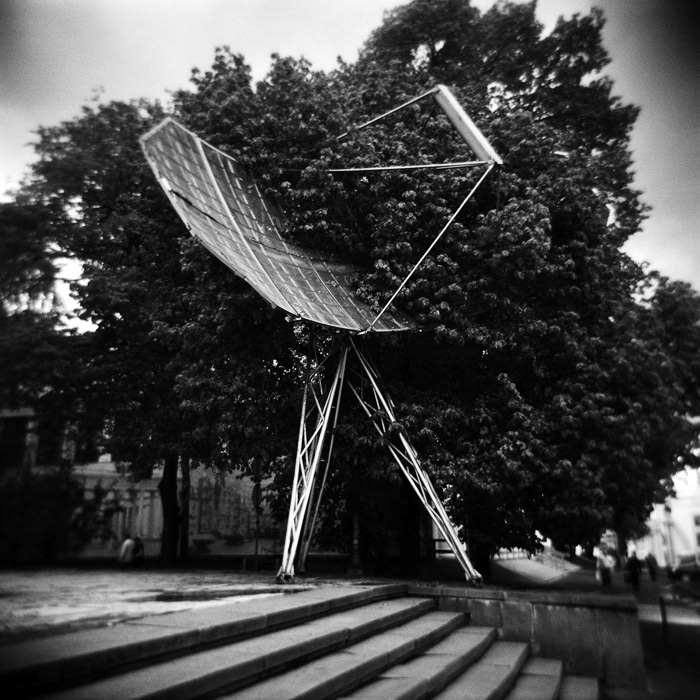
/ Antenna in front of Radioelectronics pavilion at VDNKh. /
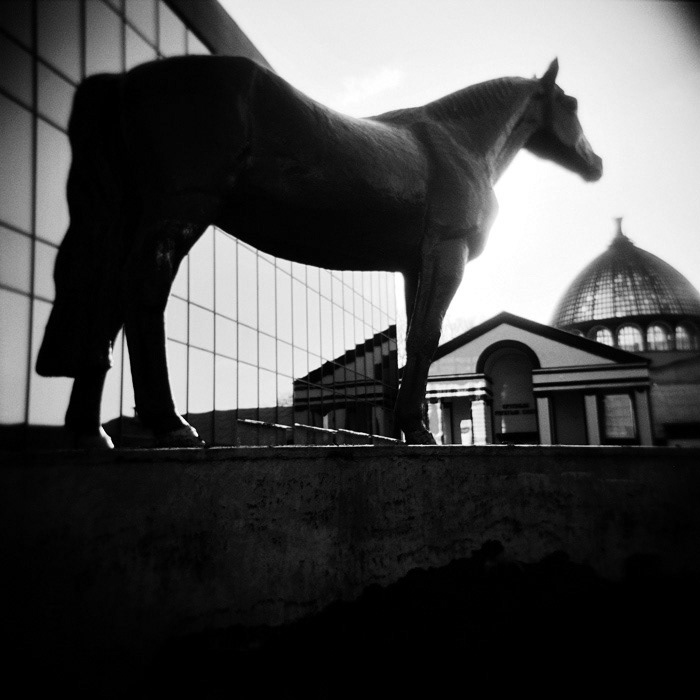
/ Monument to Kvadrat, a legendary horse of the Orlov breed, in the thereabouts of Veterinary Science pavilion, and the cupola of the Space pavilion. /
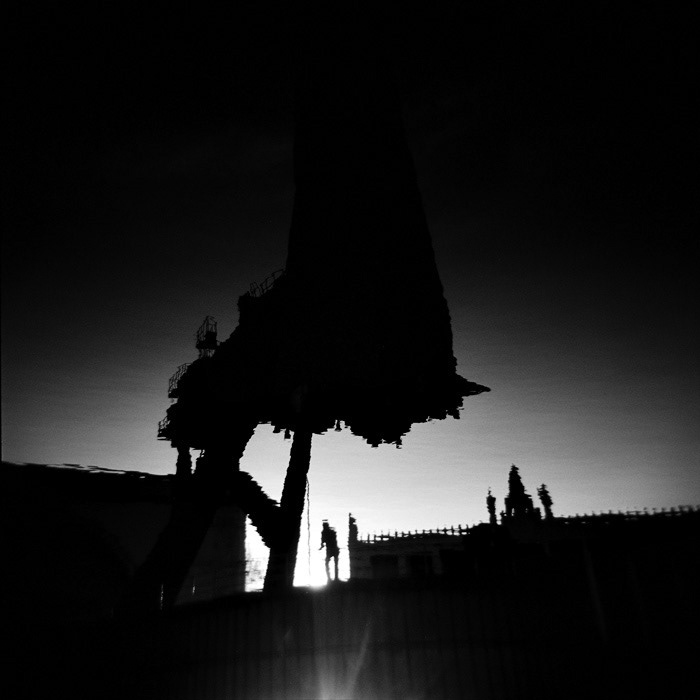
/ "Vostok" spaceship carrier rocket reflected in a fountain in front of Space pavilion. The VDNKh exhibit is an exact copy of the "Vostok" spaceship that carried Yury Gagarin, the first Soviet astronaut, into the space in 1961. /
Just like any empire, Soviet Union had an extension drive. It occupied one sixth of the Earth's surface, was bigger than the Roman empire at its best, but enough that was not. It had to conquer the space, new galaxies had to yield to its desire to expand its limits beyond the possible. Science and human resources said yes. Space was a new religion, Gagarin a new saint, a real hero.
Just like any empire, Soviet Union had an extension drive. It occupied one sixth of the Earth's surface, was bigger than the Roman empire at its best, but enough that was not. It had to conquer the space, new galaxies had to yield to its desire to expand its limits beyond the possible. Science and human resources said yes. Space was a new religion, Gagarin a new saint, a real hero.
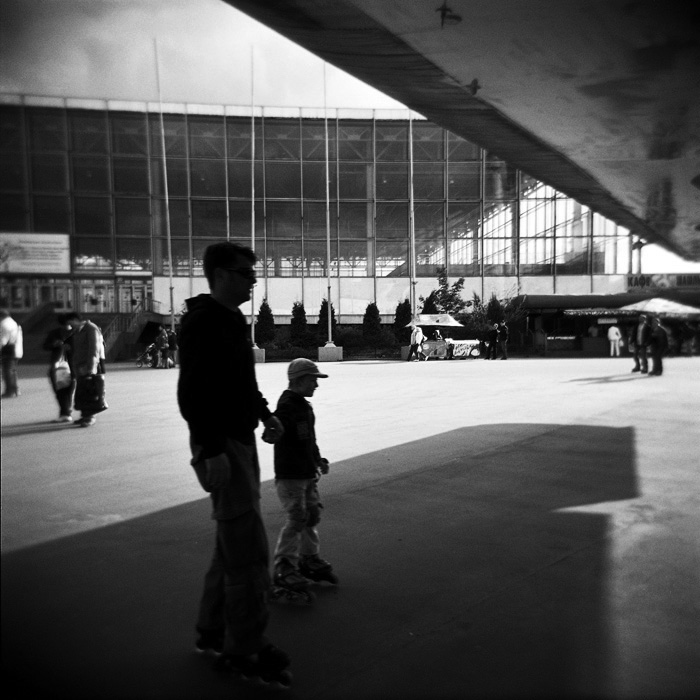
/ A father and his son roller-blading past an airplane stationed at VDNKh. /
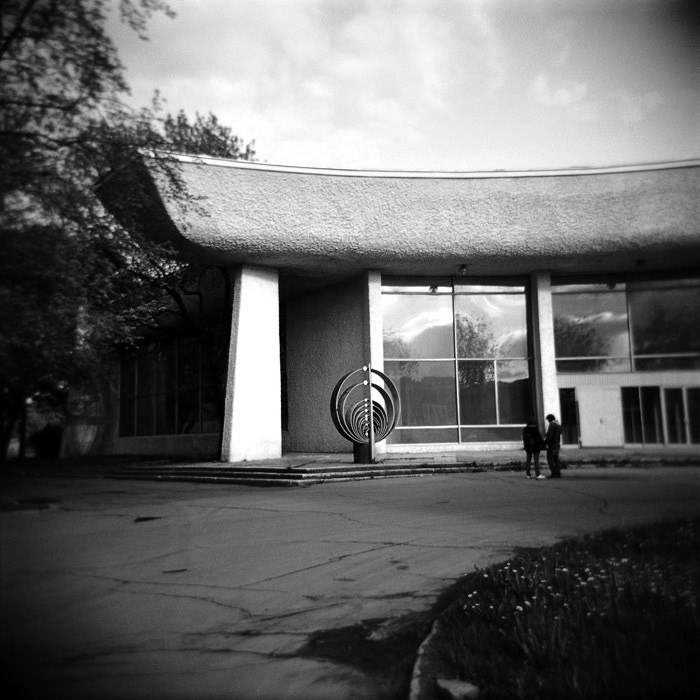
/ Gas industry pavilion, built in 1967. Architects unknown. /
VDNKh has a lot of mysteries. One of them is the name of the architect who built this pavilion, much reminiscent of le Corbusier style.
It is a known fact that le Corbusier visited USSR in the 1960s, and even took part in a number of tenders of the epoch, general plan of Moscow being one of them. Whether he himself designed this pavilion or architect(s) influenced by his genius, remains unknown. Even people working in the VDNKh archive and library are unable to answer this question. Apparently, the authorship information was completely erased, both from human memory and documents.
VDNKh has a lot of mysteries. One of them is the name of the architect who built this pavilion, much reminiscent of le Corbusier style.
It is a known fact that le Corbusier visited USSR in the 1960s, and even took part in a number of tenders of the epoch, general plan of Moscow being one of them. Whether he himself designed this pavilion or architect(s) influenced by his genius, remains unknown. Even people working in the VDNKh archive and library are unable to answer this question. Apparently, the authorship information was completely erased, both from human memory and documents.
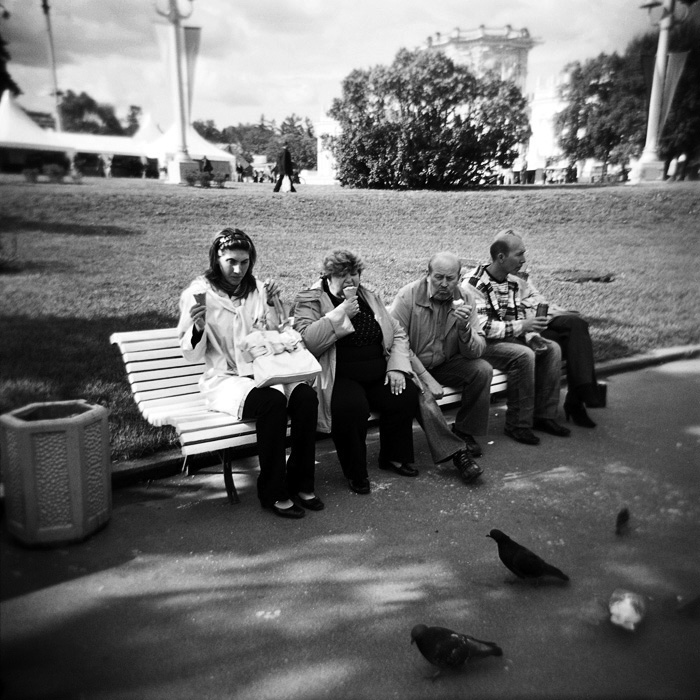
/ Ice-cream eaters in the central VDNKh alley. /
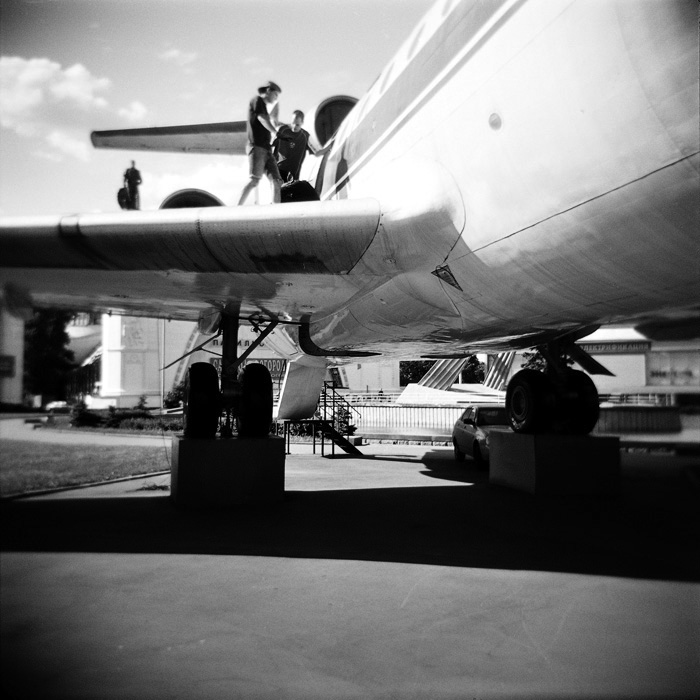
/ Repair workers on a wing of Yak-42 airplane stationed at VDNKh. /
There used to be two airplanes and a spaceship on display in front of the Space pavilion. Now just one of the aircraft remains, the other, Tu-154, being demolished a few years ago as its condition was regarded as perilous to the visitors, risking to fall to pieces any minute. Moscovites, however, were outraged by the scraping down of the legendary plane. 'They should have asked our opinion', elderly people were mourning about the recklessness of the city government's decisions.
There used to be two airplanes and a spaceship on display in front of the Space pavilion. Now just one of the aircraft remains, the other, Tu-154, being demolished a few years ago as its condition was regarded as perilous to the visitors, risking to fall to pieces any minute. Moscovites, however, were outraged by the scraping down of the legendary plane. 'They should have asked our opinion', elderly people were mourning about the recklessness of the city government's decisions.
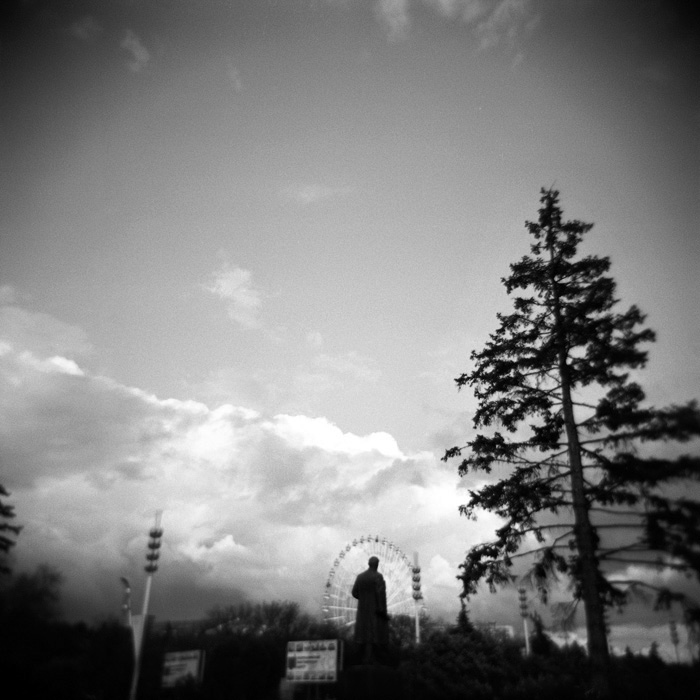
/ Lenin monument by A.Yatsyko, unveiled in 1954. /
Most of the attributes of the Soviet era are gone, but Lenin monuments will, most probably, live forever. Granit Lenins, bronze Lenins, marble Lenins, and even plaster Lenins resist the passage of time. Like Apollos and Athenes of Ancient Greece, like busts of Roman emperors they will remain in eternity to remind many and many a generation to come of the past empire that died out waiting for the future. And its huge territory will still be surveyed by the stone sentries of the past.
Most of the attributes of the Soviet era are gone, but Lenin monuments will, most probably, live forever. Granit Lenins, bronze Lenins, marble Lenins, and even plaster Lenins resist the passage of time. Like Apollos and Athenes of Ancient Greece, like busts of Roman emperors they will remain in eternity to remind many and many a generation to come of the past empire that died out waiting for the future. And its huge territory will still be surveyed by the stone sentries of the past.
Until it became an industrial display, this place was called the All-Soviet Agricultural Exhibition, opened in 1939. Before the October Revolution, and even after it, Russia was mainly an agricultural country, its income mainly coming from grain export.

